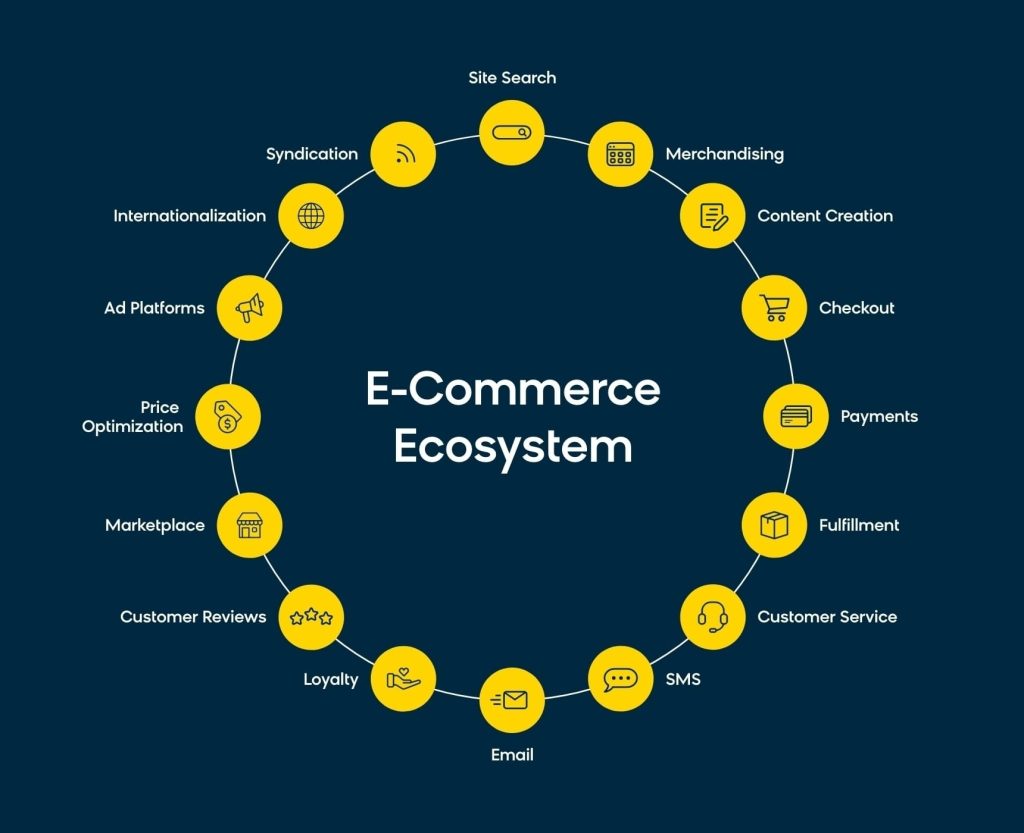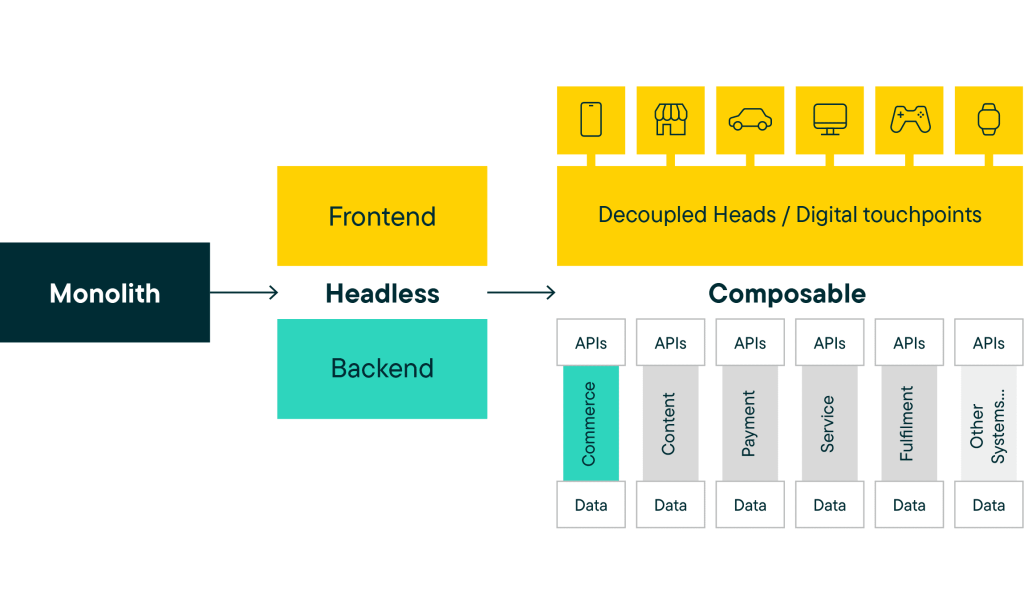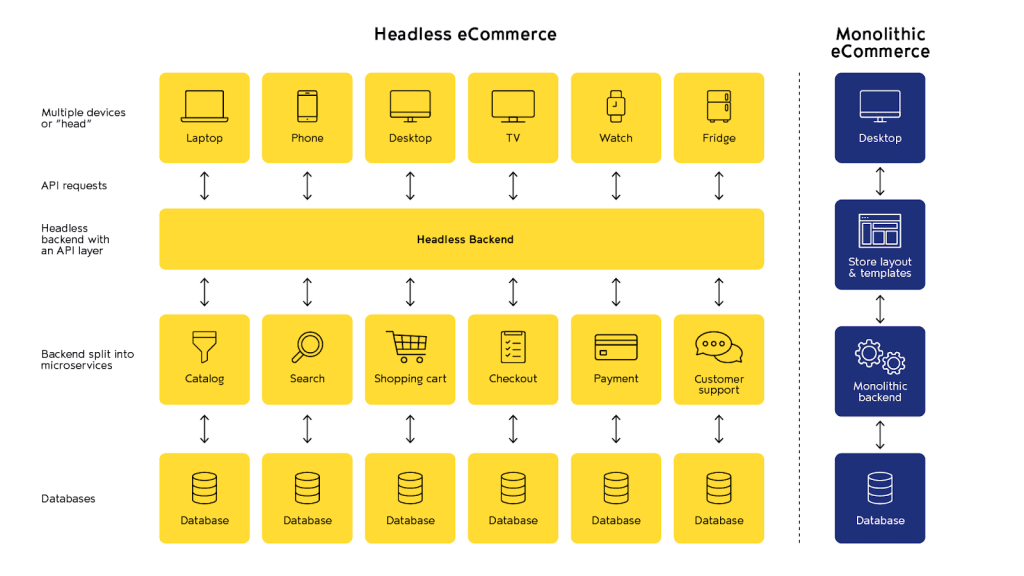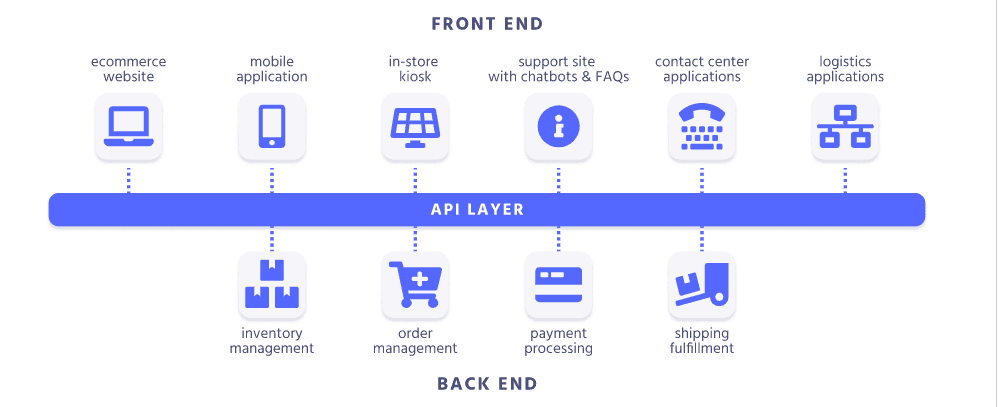Every commercial provider honing their business online gets a bunch of options for digitizing and leveraging all the eCommerce goodness available today. These options ultimately branch out into two major choices:
- to go for all-in-one solutions, readymade store themes, and simple eCommerce platforms;
- or to go deeper, create something custom, and take things to a more advanced level of resilience, performance, and quality.
If you pick the latter, the question is, how exactly do you build a unique and efficient custom architecture? The path of least resistance here would be creating a traditional monolithic structure, which is a well-trodden path. Yet it is also pretty outdated and stale.
What’s the catch with monolithic? At some point, you hit the ceiling, and it becomes pretty hard (if not impossible) to scale and expand everything you have in store.
So, if your idea of a successful business goes beyond the efficiency and profits you get here and now, you need a tech foundation for unleashing long-term potential, like the headless or emerging composable commerce approach.
What is composable commerce? And how does it help fuse the best from all worlds under the hood of an ultimately versatile, advanced, and profitable system? More importantly, why you totally shouldn’t mix composable with headless – let’s figure it all out.
What’s Composable Commerce All About?

Retail customers’ buying habits, demands, and standards have evolved dramatically ever since we acquired the ability to provide goods online a couple of decades ago. eCommerce development has been evolving in line with the times. This evolution brought us all the way from bulky, one-piece web stores (monoliths) to multi-faceted commercial systems that enable seamless omnichannel customer experiences.
As we sought better ways to boost service convenience and gather customers from different audiences in one store, eCommerce modules became a thing. Instead of limiting the focus to the big picture of your store with all its features neatly tucked in the backend, we got the “bricks” to assemble flexible architectures.
But let’s start from the beginning and get our basics straight.
Monolithic
It all started with classic monolithic software structures. Apart from the underlying database storing all the content, these structures rest on two big pillars. Backend is the “behind-the-curtain,” internal part of the software where the server, database, and application are set in motion. The part that is handled by developers and admins responsible for how the whole thing performs.
Frontend is the user interface and overall experience the software’s end user sees when they launch an application. The whole user-focused “wrapper” or presentation layer, if you will.
In monolithic solutions, the backend and frontend are firmly welded together, depending on each other as much as your house building’s balance and resilience depend on its foundation.
Headless
As software development approaches evolved, headless architectures emerged, bringing to the table slightly more up-to-date and agile structures resting on:
- Backend
- APIs
- Frontend
The main gist here is that the frontend is initially separated from the backend. It is called decoupling. And it enables developers and designers to create and optimize frontend/backend as two individual parts. APIs (application programming interfaces) come in as bridges, allowing us to connect the resulting ‘ends easily.
Some icing on the cake – one backend may power any custom frontend connected to it via API. This eCommerce development milestone gave a major boost to the general flexibility of systems.
With monolithic constraints removed, developers and providers got more freedom to explore different user-centric frontends, optimize them where needed, and efficiently scale at just the required moment.
Future-proof your store by decoupling your website front-end and back-end
Learn moreComposable
Now, you may have easily missed the exact point at which headless methodology actually evolved into the composable approach. But it has, and we must adapt if we want to grow and prosper. Why does composable commerce matter, especially in this day and age? The reasons are plentiful.
Taking things further in terms of overall agility, composable eCommerce can be assembled “brick by brick,” with every major component (e.g., payment gateway, pricing engine, etc.) coming in as a separate module.
More than that, a bunch of alternative versions of one component can be connected to a single backend, making the system more versatile for both its managers and end-users. And there’s more.
Let’s break it down and go through the main takeaways with the help of some elaborate comparisons.
Composable Commerce vs. Monolithic vs. Headless: The Showdown
While still quite prevalent among today’s eCommerce providers, monolithic architecture is showing its age under the pressure of digital challenges we are facing today. The big issue with traditional structures is that they can be pretty hard to build on, i.e., add new functionality over time, expand operating capacities, and simply scale.
Monolithic Architecture: The traditional approach

Monolithic architecture is the most traditional eCommerce building approach that basically bundles up all components (frontend+backend+databases) into a single, tightly-knit structure. This monolith can be robust but comes with major limitations, including:
- Rigidity: Monolithic systems could be more flexible. Their rigidity and stale nature live in infamy among the providers that have long moved on to more advanced methodologies. Any changes or updates here require lots of expert input and often result in internal conflicts and disruptions of all sorts (which are also hard to fix).
- Slow development: Even before you face all of the above, development in a monolithic environment is usually slow due to its complex nature. This sluggish pace can hinder a business’s ability to respond to market trends effectively.
- Scalability issues: All in all, scaling a monolithic system can be cumbersome and costly, making it challenging to keep up with sudden spikes in demand and seasonal surges.
What’s the solution? Here’s how headless and composable commerce stack up against it all.
Headless Commerce: Decoupling frontend and backend

Headless commerce makes a big departure from almost legacy monolithic systems. It decouples the front from the back, allowing businesses to upgrade or even completely replace one without affecting the other. This separation offers greater flexibility but comes with its own set of challenges, like:
- Development complexity: Building and maintaining two separate codebases for the frontend and backend is difficult on a technical level and quite time-consuming in 99% of the cases.
- Integration efforts: Ensuring seamless communication between the frontend and backend calls for careful integration work. Each component must be perfectly compatible with the other while maintaining optimal performance once connected.
Composable Commerce: The future-proof alternative

Coming in as a game-changing alternative, composable commerce embraces modularity to its fullest. It breaks down the whole eCommerce architecture into a collection of loosely coupled, interchangeable components. This tackles the limitations of monolithic and headless systems through advantages like:
- Agility: Composable commerce allows for rapid adaptation to market changes without disrupting the entire system.
- Cost efficiency: By optimizing the integration of modular components, composable commerce reduces development and maintenance costs.
- User-centricity: Composable commerce excels in delivering highly personalized user experiences, aligning perfectly with the demands of modern consumers.
- Speed-to-market: With reusable components, developers can focus on innovation, resulting in faster time-to-market for new features and updates.
More on that a bit further below. There is but one thing we should note on top of all that.
Composable Commerce vs. Microservices: Similarities and Distinctions
Exploring the nature of composable commerce, with all its disparate yet connectable modules, one can be easily reminded of microservices. Indeed, the composable approach has lots in common with the microservice methodology. The latter similarly breaks down applications into smaller bits and pieces.
But we must point out that while seemingly very similar, these are distinct concepts with unique applications in the eCommerce landscape. Let’s take a look.
Similarities
Both composable commerce and microservices draw from the concept of modularity, where complicated systems are broken down into smaller, easier-to-manage components.
Microservices’ narrower scope
However, microservice architecture focuses on creating small, single-purpose services. The big difference between these and standard eCommerce components is that microservices may run autonomously, each living a life of their own.
In certain cases, they may add unnecessary complexity to a wholesome eCommerce solution. That’s why microservice architectures are usually built for narrow-scope eCommerce solutions (for instance, Spotify employs a bunch of interconnected apps and services to grant a versatile and seamless music platform experience for every listener and creator).
Composable commerce’s business focus
Composable architecture, on the other hand, prioritizes business functions and outcomes. It relies on Packaged Business Capabilities (PBCs). Simply put, these are separate software components that are originally dedicated to a certain eCommerce function. For example, a pre-made virtual shopping cart that you can readily integrate with your store is a PBC.
Benefits and Challenges to Help You Decide
It all boils down to the question – “Should I go for composable commerce for my own eCommerce project?”. Surely, every eCommerce undertaking is unique. We hope the above info helps wrap your head around all common approaches and see the big picture of how composable commerce works.
Further details – scope of implementation, approximate budget, etc., must be discussed with professionals who will be developing your solution and guiding the project workflow. They will give you the closest estimate and heads-up across all major points.
But for the last push, here are the key benefits of composable commerce summed up and juxtaposed with its main underlying challenges. Just to give you some food for thought and analysis.

Benefits
Ultimate flexibility
Flexibility is at the heart of composable commerce. Monolithic eCommerce systems often struggle to adapt to changing market conditions and evolving customer preferences. In contrast, composable commerce offers unparalleled flexibility. Businesses can easily add, remove, or replace components to meet their specific needs, ensuring they stay agile in a dynamic market arena.
Boosted profitability
Composable commerce helps boost profitability in several ways. By allowing businesses to tailor their technology stack to exact requirements, it eliminates unnecessary costs associated with the maintenance of unused features. On top of that, with companies made agile and enabled to respond quickly to emerging opportunities and customer demands, they may expect a potential increase across all revenue streams.
Perfected user experience
Customer experience is a make-or-break factor in eCommerce. Composable commerce empowers businesses to provide highly personalized and seamless user experiences. By leveraging modular components, companies can optimize every touchpoint in the customer journey, from product discovery to checkout, hitting a higher level of customer satisfaction and loyalty.
Faster development
Time-to-market is crucial for any ambitious provider. Composable commerce speeds up development cycles dramatically. Developers can harness pre-built, reusable components, saving valuable time and effort. This speed advantage allows businesses to launch new features, campaigns, or even entirely new storefronts faster than ever before.
Challenges
Complexity
While composable commerce offers immense flexibility, it may come at a cost. Managing a constellation of modular services and ensuring they work seamlessly together can be challenging. Mitigating this calls for effective governance and in-depth architectural oversight, which can only be granted by reliable specialists working at your side.
Time-to-market
Paradoxically, although composable commerce can really speed up development, the initial setup of a composable ecosystem may take more time than deploying a monolithic solution. Companies must carefully plan their composable architecture to avoid delays in their go-to-market strategies.
Support and maintenance
Maintaining a composable commerce system requires ongoing attention. As businesses add or modify components, they must make sure all integrations remain stable, security is maintained, and scalability potential is not compromised. Adequate support and maintenance resources are necessary to sustain the system’s long-term viability.
Composable Commerce Migration
In fact, the decision to move to composable commerce is a tangible implementation of the need for tactical businesses to make them tuneable, agile, and to some extent, customizable with end-users. This part of the discussion focuses on why and how businesses migrate to composable commerce platforms; and addresses both the intermediate benefits during the migration process and notable advantages following the transition to the new ecosystem.
Why Businesses Migrate to Composable Commerce
Currently, ecommerce is the main way of doing business, but a lot of companies find themselves limited by the inflexibility of traditional systems with a single viewpoint and a lack of adaptation to the market requirements and technology breakthroughs. The basic drivers being served by local companies are the quest for more mobility, the capacity to utilize the latest technologies and the ambition for the best, personalized customer service. Adventurous companies are susceptible to expansion or those willing to go into new markets also see composable commerce as a decent way to quickly grow the same role without complicated infrastructure.
Key Steps in the Migration Process
Moving to a composable commerce platform consists of several important steps to facilitate the change smoothly and maintain business operations as usual. That usually begins with a thorough assessment of the already existing digital assets, as well as a detailed mapping the business needs to functions to perform. It is then followed by the choosing of appropriate modules that will be able to fulfill these needs mainly through a combination of third-party services that excel in their area and custom-built solutions. Actually, migration the process requires preparation and can use staged rollouts with feedback so that it will not interrupt ongoing operations.
Benefits Realized After Migration
Firstly, having chosen their new business location pattern, companies eventually experience a large number of positive changes that benefit their operations. The options with which companies enjoy enhanced operational flexibility like adopting to customers’ expectations swiftly or in the market conditions’ volatility with minimum developmental costs are natural consequences. And here is where the lowering of the total cost of ownership comes in as the companies now just invest in the number of modules they require and without undergoing through the entire system, it makes it possible for them to replace it. Above all, there is modularity in composable commerce which is associated with better quality of customer experience that leads purchasers to return and results in the gain of the revenue growth.
Final Word
With all that being said, picking the path of composable commerce architecture is not necessarily a win-for-all decision that EVERY other eCommerce provider should go by just to make it in the market. You may as well secure your shiny spot with an all-around efficient monolith. And yet the composable methodology offers so much more. More depth, more personalization, and more far-sighted opportunities.
Furthermore, all three of the above-mentioned challenges are handled right away, simply by turning to a reliable team of specialists. So make sure well-qualified professionals help you make further major decisions and good luck!
Create a responsive web design for ecommerce
Learn moreFAQ
What is composable commerce, and how does it differ from traditional e-commerce?
Composable commerce is an eCommerce development approach that breaks down the online store’s architecture into modular, interchangeable components. Unlike traditional monolithic systems, composable commerce solutions offer unmatched flexibility, allowing businesses to select and integrate best-of-breed solutions for specific functions, such as cart management or product recommendations. This approach provides greater agility and customization options.
What are the key benefits of adopting composable commerce?
Composable commerce offers a range of advantages over conventional approaches, including a good ability to adapt to changing market conditions, streamlined profitability through optimized solutions, enhanced user experiences, speedier development times, and the ability to create tailored solutions for specific business needs.
Is composable commerce only suitable for large enterprises?
While composable commerce is often associated with large enterprises due to the potential range of complexity and opportunities it grants, it can benefit businesses of all sizes. Small and medium-sized businesses can leverage composable architectures to adapt quickly to market shifts, polish out user experiences, and scale all operations efficiently.
How does composable commerce impact the user experience?
Composable commerce allows businesses to create unique, tailored, and smooth user experiences. By selecting specialized components for functions like user personalization, checkout, and content management, you can optimize each aspect of the customer journey, achieving higher customer satisfaction and increased conversions.
What challenges should businesses consider when adopting composable commerce?
While offering numerous benefits, a composable approach comes with its challenges. These include the potential complexity of integrating various components, possible longer time-to-market during the initial setup, and the need for ongoing support and maintenance. Businesses should ensure they have the technical expertise and resources to effectively manage a composable architecture.


